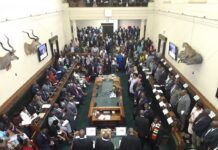
By Talkmore Gandiwa
The sun had barely crept above the eastern ridgelines when the first crackle of gravel under tyres echoed across the fresh tarmac. It was the sort of morning that whispered of promises — golden light bouncing off guardrails, the crisp scent of new asphalt lingering in the air.
A convoy of Fossil construction vehicles stood silently to the side, their work done. And where there was once a chaotic weave of detours, dust, and traffic snarls, now stood a marvel: the newly opened Trabablas Interchange, a keystone of Zimbabwe’s bold “New Testament” in road revitalisation.
For years, Trabablas formerly Mbudzi roundabout was synonymous with gridlock — a place where east met west and neither moved. Commuters cursed it, Long-distance drivers detoured around it, Taxi operators prayed to beat the morning madness, a bottleneck and a blackspot rolled into one. But today, that narrative has changed.
As the ribbon-cutting ceremony reached its climax, the sound of ululation rang through the crisp morning air. Minister of Transport and Infrastructure Development, Felix Mhona, stood beneath a gleaming archway of steel and pride, flanked by engineers in white helmets, children waving miniature flags, and elders who had witnessed the road’s long and bumpy journey.
“We are not just opening a road today,” Mhona said. “We are opening a new chapter. This interchange is a testament to what vision, unity, and modern engineering can achieve. This is our New Testament — not of scripture, but of infrastructure.”
Indeed, the Trabablas Interchange is more than a feat of civil engineering. It’s a symbol — a convergence of policy, ambition, and human resilience. The government spent US$ 88 million in building the first interchange with 15 bridges, 13 are part of the interchange and 2 are nearby.
The elegantly braided lanes now replace the chaotic tangle that once choked this critical junction. Elevated flyovers lift traffic out of the dust, allowing uninterrupted flow from four major directions. LED lighting twinkles overhead at night like constellations guiding weary travellers. Underground pedestrian tunnels, wheelchair-friendly walkways, and solar-powered traffic sensors reflect a shift towards inclusive and sustainable development.
But perhaps the story is best told not in technical blueprints, but in the voices of those who lived through the before and now bask in the after.
To a fellow countrymen the interchange came as a surprise, from the glimmering of the sunrise to the setting of the sun, people continue to tour and appreciate the beauty that has been set as beacon of road transformation.
Tawanda Munetsi, 38, who used to sell soft drinks and water at the Trabablas layby for over three decades. His makeshift stall, shaded by torn canvas and stubborn optimism, once sat just metres from the edge of the old road — dangerously close to speeding vehicles and suffocated by dust clouds.
“Before this road, I’d lose half my produce to dirt every day,” he says, his weathered hands gesturing at the newly paved sidewalk. “People couldn’t even stop safely to buy.”
The Trabablas Interchange is just one star in a growing constellation. It’s part of the National Transport Infrastructure Revitalisation Plan (NTIRP) — a US$1.2 billion initiative aiming to modernise over 3,000 kilometres of road by 2028.
Backed by a mix of state funding, private investment, and support from regional development banks, the plan has been dubbed the “New Testament” of Zimbabwean transport by media pundits and government officials alike.
Unlike the ad-hoc, pothole-patching days of the past, this “New Testament” is rooted in long-term vision: sustainable roads, smart mobility, local employment, and regional integration.
As dusk fell, the Trabablas Interchange took on a cinematic hue — headlights gliding like fireflies across the bends, the bridge casting long, elegant shadows. The air, once filled with dust and despair, now carried the quiet rhythm of motion and the distant hum of a country on the move.
The interchange may be concrete and steel, but it is also poetry — a stanza in Zimbabwe’s evolving story of rebirth, ambition, and hope. A literal crossroads that became a metaphorical one.
And as the first night lights blinked into life, one thing was clear: the New Testament of road revitalisation had found its gospel — and it began right here, at Trabablas.














